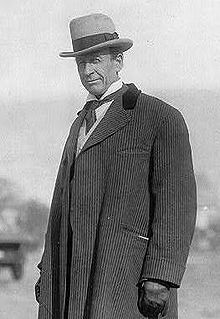- Moses Kinkaid
-
Moses Pierce Kinkaid (January 24, 1856 – July 6, 1922) was a member of the United States House of Representatives from Nebraska. He was the sponsor of the 1904 Kinkaid Land Act, which allowed homesteaders to claim up to 640 acres (260 ha) of government land in western Nebraska.[1]
Contents
Early life and career
Kinkaid was born near Morgantown, Virginia, which is now in West Virginia.[2] As a boy, he piloted fugitive slaves coming from the South and headed for Canada, to his grandparents' home in Pennsylvania, where food, shelter, and aid were given to them.[3] He attended the public schools and graduated from the law department of the University of Michigan at Ann Arbor in 1876.[2] He was admitted to the bar and practiced in Henry County, Illinois from 1876 until 1880 and in Pierre, Dakota Territory in 1880 and 1881.[2] In 1881, he moved to O'Neill, Nebraska, where he maintained his residence until his death.[4]
In O'Neill, Kinkaid continued to practice law. He also served as an officer of the Holt County Bank from its foundation in 1884 until 1886.[4] He served in the state Senate in 1883,[2] and as a district judge from 1887 to 1900.[4]
In 1900, Kinkaid unsuccessfully sought election to the U.S. House of Representatives from Nebraska's Sixth District.[2] In 1902, he ran for the same position, this time successfully.
The Kinkaid Act
The Sixth District contained most of the Nebraska Sandhills,[4] This is a region of grass-stabilized sand dunes.[5] Rainfall percolates readily into the sandy soil, recharging the aquifer and giving rise to hundreds of permanent lakes; but the sandy soil is poorly suited for cultivation, and the area is chiefly used for cattle ranching.[6]
At the time that Kinkaid entered Congress, the 1862 Homestead Act allowed settlers to obtain a quarter-section (160 acres, or 65 ha) of government land for a nominal fee; the 1873 Timber Culture Act allowed them to claim an additional quarter-section.[7] However, in much of the Sandhills a half-section was not enough land to sustain a family.[8] Instead, the pattern of development was one of large cattle ranches on federal land,[6] with the ranchers using the homestead laws to secure lakes and streams for their operations.[8]
In an effort to increase settlement in the northwestern portion of his state, Kinkaid sponsored and obtained passage of the Kinkaid Act, which amended the Homestead Act to enlarge the size of a homestead claim in certain arid regions of western Nebraska. Settlers on non-irrigable lands west of the 98th Meridian could claim up to 640 acres (260 ha).[8] The measure was signed by President Theodore Roosevelt in 1904.[4]
The Act had its intended effect: immigration into the Sandhills increased, with nearly nine million new acres (3,600,000 ha) claimed in Nebraska.[6] By 1912, most of the land available had been claimed by "Kinkaiders".[8] Attempts to farm the land thus obtained generally failed; but Kinkaid claims, together with regulations prohibiting fencing of federal land, led to the replacement of a few large ranches in the Sandhills with many smaller ones.[6] The outcome of the Nebraska law led to the passage of the 1916 Stock-Raising Homestead Act, which extended many of the provisions of the Kinkaid act to other Western states.[8]
Later life and legacy
Kinkaid held his Congressional seat as a Republican until his death.[4] In the 66th and 67th Congresses (1919–1922), he was Chairman of the Committee on Irrigation of Arid Lands. He died in Washington, D.C. on July 6, 1922,[2] shortly before the end of his tenth term in office.[4] He was buried in Prospect Hill Cemetery in O'Neill, Nebraska.[2]
The Old Nebraska State Bank Building in O'Neill, in which Kinkaid had his law office from 1884 until his death, is now the Holt County Historical Museum.[9] It is listed in the National Register of Historic Places.[4] Kinkaid's office has been restored and is on display.[10]
References
- ^ "Kimball County". Nebraska State Historical Society. Retrieved 2010-04-24.
- ^ a b c d e f g "KINKAID, Moses Pierce, (1856-1922)". Biographical Directory of the United States Congress. Retrieved 2010-04-24.
- ^ Humphrey, A. R. (1924). Quoted in Memorial Addresses Delivered in the House of Representatives in Memory of Moses P. Kinkaid, Late a Representative from Nebraska. Government Printing Office. p. 5.
- ^ a b c d e f g h Kolberg, Persijs (1974). National Register of Historic Places Nomination Form: Old Nebraska State Bank Building. Nebraska State Historical Society. Retrieved 2010-04-24.
- ^ Dutch, Steven (2003). Nebraska Sand Hills. Retrieved 2010-04-24.
- ^ a b c d "The Sandhills". Nebraska State Historical Society. Retrieved 2010-04-24.
- ^ "U.S. Government Land Laws in Nebraska, 1854-1904". Nebraska State Historical Society. Retrieved 2010-04-24.
- ^ a b c d e Kay, John and Mary Findlay (1988)."Nebraska Historic Buildings Survey, Reconnaissance Survey Final Report of Holt County, Nebraska". Nebraska State Historical Society. Retrieved 2010-04-24.
- ^ "Moses P. Kinkaid Law Office Museum". Holt County Historical Society. Retrieved 2010-04-24.
- ^ "Inside the Museum". Holt County Historical Society. Retrieved 2010-04-24.
External links
- Moses Kinkaid at the Biographical Directory of the United States Congress
- Moses P. Kinkaid Law Office Museum (O'Neill, Nebraska)
- Moses Kinkaid at Find a Grave
United States House of Representatives Preceded by
William Neville (Populist)Member of the U.S. House of Representatives
from Nebraska's 6th congressional district
1903 – 1922Succeeded by
Augustin Reed Humphrey (R)Categories:- 1856 births
- 1922 deaths
- Members of the United States House of Representatives from Nebraska
- Nebraska State Senators
- Nebraska lawyers
- University of Michigan alumni
Wikimedia Foundation. 2010.


